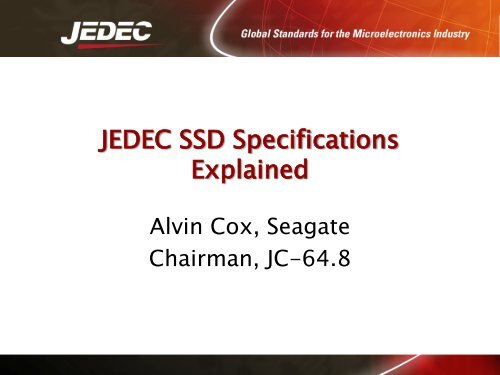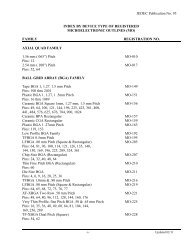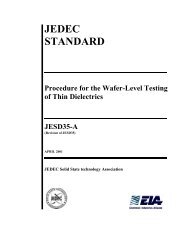JEDEC SSD Specifications Explained
JEDEC SSD Specifications Explained
JEDEC SSD Specifications Explained
You also want an ePaper? Increase the reach of your titles
YUMPU automatically turns print PDFs into web optimized ePapers that Google loves.
<strong>JEDEC</strong> <strong>SSD</strong> <strong>Specifications</strong><br />
<strong>Explained</strong><br />
Alvin Cox, Seagate<br />
Chairman, JC-64.8
<strong>JEDEC</strong> <strong>SSD</strong> Standards<br />
‣ JESD218, Solid State Drive (<strong>SSD</strong>)<br />
Requirements and Endurance Test<br />
Method<br />
‣ JESD219, Solid State Drive (<strong>SSD</strong>)<br />
Endurance Workloads
What do these standards include?<br />
‣ <strong>SSD</strong> Requirements<br />
– <strong>SSD</strong> Definitions<br />
– <strong>SSD</strong> Capacity<br />
– Application Classes<br />
– Endurance Rating<br />
– Endurance Verification<br />
‣ <strong>SSD</strong> Endurance Workloads<br />
– Client<br />
– Enterprise
Scope of JESD218<br />
‣ Define <strong>JEDEC</strong> requirements for <strong>SSD</strong>s,<br />
classes of <strong>SSD</strong>s, and the conditions<br />
of use and corresponding endurance<br />
verification requirements.<br />
‣ The standard is sufficient for the<br />
endurance and retention part of <strong>SSD</strong><br />
qualification.<br />
‣ Developed for <strong>SSD</strong>s with NAND NVM.
Reference Documents<br />
‣ JESD22-A117, Electrically Erasable<br />
Programmable ROM (EEPROM) Program/Erase<br />
Endurance and Data Retention Stress Test<br />
‣ JESD47, Stress-Test-Driven Qualification of<br />
Integrated Circuits<br />
‣ JEP122, Failure Mechanisms and Models for<br />
Semiconductor Devices<br />
‣ JESD219, Solid State Drive (<strong>SSD</strong>) Endurance<br />
Workloads
Key Definitions<br />
‣ Endurance failure<br />
– A failure caused by endurance stressing.<br />
‣ Endurance rating (TBW rating)<br />
– The number of terabytes that may be written<br />
to the <strong>SSD</strong> while still meeting the<br />
requirements.
Key Definitions<br />
‣ Erase block<br />
– The smallest addressable unit for erase<br />
operations, typically consisting of multiple<br />
pages.<br />
‣ Page<br />
– A sub-unit of an erase block consisting of a<br />
number of bytes which can be read from and<br />
written to in single operations, through the<br />
loading or unloading of a page buffer and the<br />
issuance of a program or read command.
Key Definitions<br />
‣ Program/erase cycle<br />
– The writing of data to one or more pages in<br />
an erase block and the erasure of that block,<br />
in either order.<br />
‣ Retention failure<br />
– A data error occurring when the <strong>SSD</strong> is read<br />
after an extended period of time following<br />
the previous write.
Key Definitions<br />
‣ Solid state drive<br />
– A solid state drive (<strong>SSD</strong>) is a non-volatile<br />
storage device. A controller is included in the<br />
device with one or more solid state memory<br />
components. The device should use<br />
traditional hard disk drive (HDD) interfaces<br />
(protocol and physical) and form factors.
Key Definitions<br />
‣ Unrecoverable Bit Error Ratio (UBER)<br />
– A metric for the rate of occurrence of data<br />
errors, equal to the number of data errors per<br />
bits read.
Key Definitions<br />
‣ Write amplification factor (WAF)<br />
– The data written to the NVM divided by<br />
data written by the host to the <strong>SSD</strong>.
UBER of HDDs and <strong>SSD</strong>s<br />
# corrupt sectors per drive<br />
0.06<br />
0.05<br />
0.04<br />
0.03<br />
0.02<br />
0.01<br />
0<br />
Example: 70GB, TBW rating = 70TB<br />
<strong>SSD</strong><br />
HDD<br />
0 200 400 600 800 1000<br />
Drive Rewrites<br />
UBER rating<br />
TBW rating<br />
Material submitted by Intel
# corrupt sectors per drive<br />
UBER equality question<br />
0.06<br />
0.05<br />
0.04<br />
0.03<br />
0.02<br />
0.01<br />
0<br />
Example: 70GB, TBW rating = 70TB<br />
<strong>SSD</strong><br />
HDD<br />
0 200 400 600 800 1000<br />
Drive Rewrites<br />
Does allowing the limit to<br />
intersect the constant line<br />
result in a much worse UBER at<br />
that point in time than the<br />
specification limit?<br />
Instantaneous UBER for the spec limit is when<br />
dx/dt of <strong>SSD</strong> UBER = dx/dt of constant UBER =<br />
Specification limit (i.e., slope of tangent line to<br />
curve equals that of a constant UBER over life<br />
slope)
UBER<br />
‣ Lifetime-average is the standard in<br />
reliability (may be more familiar by its<br />
equivalent name, cumulative % fail).<br />
Instantaneous slope is not used as the<br />
basis for qualification.<br />
‣ Lifetime average is in the draft because it<br />
is the most accurate value to use and the<br />
most consistent with prior practice.
UBER determination<br />
‣ Although the UBER concept is in widespread use in the<br />
industry, there is considerable variation in interpretation.<br />
In this JESD218, the UBER values for <strong>SSD</strong>s are lifetime<br />
values for the entire population.<br />
– The numerator is the total count of data errors detected over the full<br />
TBW rating for the population of <strong>SSD</strong>s, or the sample of <strong>SSD</strong>s in the<br />
endurance verification.<br />
– A sector containing corrupted data is to be counted as one data<br />
error, even if it is read multiple times and each time fails to return<br />
correct data.<br />
– The denominator is the number of bits written at the TBW rating<br />
limit, which aligns to the usual definition of errors per bit read when<br />
the read:write ratio is unity.
WAF<br />
‣ Write amplification factor (WAF)<br />
– The data written to the NVM divided by<br />
data written by the host to the <strong>SSD</strong>.<br />
‣ An <strong>SSD</strong> usually writes more data to<br />
the memory than it is asked to<br />
write.<br />
‣ The nature of the workload plays a<br />
significant role.
WAF<br />
‣ Factors that impact WAF:<br />
– Sequential versus random<br />
– Large transfers versus small ones<br />
– Boundary alignment<br />
– Data content/patterns (especially for<br />
<strong>SSD</strong>s using data compression)
WAF example<br />
‣ Because NAND can only be written to after having been<br />
erased, and the granularity of erasure is coarse (referred<br />
to as the Erase Block), some NAND management<br />
algorithms can result in a large amount of data being<br />
written to NAND for a modest amount requested to be<br />
written by the host. The multiplication factor that<br />
describes how much larger the ultimate write to the NAND<br />
becomes is known as write amplification. For example, if a<br />
host write of 4KB results in a write to the NAND of 16KB,<br />
then the write amplification is 4.<br />
Material submitted by Intel
WAF example<br />
The figure shows one NAND block<br />
comprised of 64 pages. For this<br />
example, assume that each page is<br />
2KB in size (four sectors) giving a total<br />
of 256 sectors per block. This block<br />
has valid host data in all of its pages.<br />
Assume that the host writes only some<br />
pages in this block with new data as<br />
illustrated on the next slide.<br />
Material submitted by Intel
WAF example<br />
In NAND, before programming a page it has to be first<br />
erased and the erase granularity in NAND is in blocks.<br />
Therefore to program the 8 sectors shown in yellow in<br />
Figure 2 above, one possible approach is to use a<br />
read/modify/write algorithm as follows:<br />
1. Copy entire block (page 0 to page 63) to DRAM.<br />
2. Modify pages 1, 2 and 3 with the new data that the<br />
host wants to write. DRAM now has the block as<br />
shown in the figure with the new Host data.<br />
3. Erase the block in the NAND.<br />
4. Program the block with the data from DRAM. (This is<br />
equivalent to writing 256 sectors in the NAND.)<br />
With this implementation, a host write of 8 sectors<br />
resulted in a NAND write of 256 sectors. The write<br />
amplification for this example is 32 (256/8).<br />
Material submitted by Intel
WAF example<br />
Note that had the example above used a larger<br />
transfer that spanned the entire erase block (or<br />
sequential transfers that could be internally<br />
buffered in the <strong>SSD</strong> to fill the entire erase block)<br />
that the write amplification would essentially be<br />
1 since the entire erase block would have new<br />
data to be written. The nature of the workload<br />
has substantial impact on resulting write<br />
amplification and in general small random<br />
writes tend to create the largest write<br />
amplification values.<br />
Material submitted by Intel
<strong>SSD</strong> capacity<br />
‣ <strong>SSD</strong> Capacity in Gbytes = (Useraddressable<br />
LBA count - 21168) /<br />
1953504<br />
− Same value as IDEMA for HDDs except no<br />
50GB limit<br />
− Requested by OEMs for ease of<br />
implementation (HDD or <strong>SSD</strong>)<br />
− This version for 512 byte sectors<br />
− 4k sector version in development
Application classes<br />
‣ Current application classes:<br />
− Client<br />
− Enterprise<br />
‣ Application classes attributes:<br />
− Workload<br />
− Data retention<br />
− BER
Endurance rating<br />
‣ Establish a rating system for comparing <strong>SSD</strong>s.<br />
‣ Provides unique rating for application class.<br />
‣ Rating based on a user-measurable interface<br />
activity: TBW.<br />
‣ TBW = TeraBytes Written.<br />
− “Decimal” value to be consistent with user interfaces.
Endurance rating<br />
The <strong>SSD</strong> manufacturer shall establish an endurance rating for an<br />
<strong>SSD</strong> that represents the maximum number of terabytes that may be<br />
written by a host to the <strong>SSD</strong>, using the workload specified for the<br />
application class, such that the following conditions are satisfied:<br />
1) the <strong>SSD</strong> maintains its capacity;<br />
2) the <strong>SSD</strong> maintains the required UBER for its application class;<br />
3) the <strong>SSD</strong> meets the required functional failure requirement (FFR)<br />
for its application class; and<br />
4) the <strong>SSD</strong> retains data with power off for the required time for its<br />
application class.<br />
This rating is referred to as TBW. Requirements for UBER, FFR, and<br />
retention are defined for each application class.
<strong>SSD</strong> endurance classes and<br />
requirements<br />
Application<br />
Class<br />
Workload Active Use<br />
(power on)<br />
Client Client 40 o C<br />
8 hrs/day<br />
Enterprise Enterprise 55 o C<br />
24hrs/day<br />
Retention<br />
Use<br />
(power off)<br />
30 o C<br />
1 year<br />
40 o C<br />
3 months<br />
Functional<br />
Failure<br />
Rqmt (FFR)<br />
UBER<br />
�3% �10 -15<br />
�3% �10 -16
Temperatures and data retention<br />
‣ Tables show # weeks<br />
retention as a function of<br />
active and power-off<br />
temperatures.<br />
‣ Numbers are based on<br />
Intel‟s published<br />
acceleration model for the<br />
detrapping retention<br />
mechanism (the official<br />
<strong>JEDEC</strong> model in JESD47 and<br />
JEP122 for this<br />
mechanism).<br />
Material submitted by Intel
Endurance rating example<br />
Using the appropriate workload, the <strong>SSD</strong> manufacturer may<br />
determine the relationship between host writes and NAND<br />
cycles, the latter being the number of p/e cycles applied to<br />
any NAND block, and use this relationship to estimate the<br />
<strong>SSD</strong> endurance rating. If the <strong>SSD</strong> employs more than one<br />
type of NAND component with different cycling capabilities,<br />
then a separate relationship should be obtained for each<br />
type of NAND. If operating the <strong>SSD</strong> to the desired TBW is<br />
impractical because time required would be excessive, then<br />
the relationship between NAND cycles and host writes should<br />
be extrapolated. In performing the extrapolation, any<br />
nonlinearities in <strong>SSD</strong> operation, such as those resulting from<br />
a reduced cycling pool at extended cycles, should be<br />
accounted for.
Endurance rating example<br />
The estimated endurance rating is the TBW such that<br />
f(TBW) < NAND cycling capability (1)<br />
where f(TBW) expresses maximum NAND cycles as a function<br />
of TBW. The relationship may be different for different types<br />
of NAND components used in the <strong>SSD</strong>.<br />
Consider an <strong>SSD</strong> containing only one type of NAND and no<br />
features of the drive design that would make the WAF change<br />
over the lifetime of the drive. Suppose further that the<br />
design of the wear leveling method is expected to result in<br />
the most heavily-cycled erase block receiving twice the<br />
average number of cycles.
Endurance rating example<br />
In that case, WAF would be a constant (for a given workload),<br />
and<br />
f(TBW) = (TBW × 2 × WAF) / C<br />
where C is the <strong>SSD</strong> capacity and the factor of two is the<br />
guard band for the wear leveling effects. The <strong>SSD</strong> endurance<br />
rating would then become<br />
TBW < (C × NAND cycling capability) / (2 × WAF)<br />
In the more general case, WAF may not be a constant. More<br />
extensive characterization would be needed to determine<br />
f(TBW) in equation (1) before estimating the endurance<br />
rating.
Endurance rating example<br />
The NAND cycling capability is obtained from component<br />
qualification data. The WAF may be obtained from <strong>SSD</strong> data<br />
using the specified workload for endurance testing.<br />
Measurement of WAF requires access to information about<br />
NAND program/erase cycles which is generally not available<br />
to third parties. Under the assumption in this example where<br />
WAF is constant, WAF may be measured after operating the<br />
<strong>SSD</strong> long enough to reach a steady state, without needing to<br />
operate the drive to its full endurance rating. The guard band<br />
for wear leveling effects (two in this example) may be<br />
measured from similar <strong>SSD</strong> data or estimated from the<br />
design of the wear leveling scheme.
Endurance verification
Verification goals<br />
‣ Reasonable test time (1,000 hours)<br />
‣ Reasonable sample size<br />
‣ Applicable to multiple designs<br />
‣ Extendable to an <strong>SSD</strong> “family”<br />
Produce the right answer!
Direct versus extrapolation<br />
‣ Two methods described in the<br />
specification:<br />
− Direct<br />
− Extrapolation<br />
‣ Direct method runs the <strong>SSD</strong> to 100% of<br />
P/E cycles.<br />
‣ Extrapolation method requires:<br />
− Knowledge of component characteristics<br />
− Information normally available only to the<br />
<strong>SSD</strong> manufacturer
Direct versus extrapolation<br />
‣ Both methods:<br />
− Count only failures based on<br />
endurance<br />
− Include high and low temperature test<br />
lots<br />
− Require sample sizes supporting a<br />
60% statistical confidence level
Temperature lots<br />
‣ Different temperatures introduce different<br />
NAND failure mechanisms.<br />
‣ It is necessary to test both at elevated and low<br />
temperatures.<br />
‣ Two approaches are acceptable for<br />
incorporating both high and low temperatures<br />
into the endurance stressing: the rampedtemperature<br />
approach and the split-flow<br />
approach.<br />
‣ The preferred temperature measurement is the<br />
temperature reported by the <strong>SSD</strong> if it has that<br />
capability (ATA and SCSI statistics).
Direct method<br />
‣ Best method but not likely to be used.<br />
‣ <strong>SSD</strong>s are stressed to their stated endurance<br />
rating (in TBW) using specified workloads.<br />
‣ The endurance stressing is to be performed at<br />
both high and low temperatures.<br />
‣ Following this endurance stressing, retention<br />
testing shall be performed. Since the retention<br />
use time requirements are long, extrapolation or<br />
acceleration is required to validate that the <strong>SSD</strong><br />
meets the retention requirement.
Extrapolation methods<br />
‣ Extrapolation methods may be used if the<br />
direct method would require more than<br />
1000 hours of endurance stress.<br />
‣ Most of these methods require special<br />
access to <strong>SSD</strong> internal operations or to<br />
NVM component information which make<br />
these methods possible only for the<br />
manufacturer of the <strong>SSD</strong>.
General requirements for<br />
extrapolation methods<br />
1. The <strong>SSD</strong> must meet the requirements for FFR and UBER for the<br />
temperatures and times stated in the table.<br />
2. The FFR and UBER requirements must be met for both lowtemperature<br />
and high-temperature endurance stressing.<br />
3. Data retention is to be verified under the assumption that the<br />
endurance stressing in use takes place over no longer than 1<br />
year at the endurance use temperature and hours per day of use<br />
are as specified per application class.<br />
4. Data retention is to be verified both for a temperatureaccelerated<br />
mechanism (1.1eV) and a non-temperatureaccelerated<br />
mechanism.<br />
5. All requirements are to be established at 60% statistical<br />
confidence.
Extrapolation methods<br />
‣ Accelerated write rate through<br />
modified workload<br />
‣ Extrapolation of FFR and badlocation<br />
trends<br />
‣ FFR and UBER estimation from<br />
reduced-capacity <strong>SSD</strong>s<br />
‣ FFR and UBER estimation from<br />
component data
Accelerated write rate through<br />
modified workload<br />
‣ The workload in the endurance stress is<br />
modified so that more p/e cycles can be<br />
performed on the nonvolatile memory in a given<br />
amount of time.<br />
‣ Example of acceptable modified workloads are:<br />
– 1. A workload with a different ratio of sequential to<br />
random writes, or different transfer sizes.<br />
– 2. A workload which includes proprietary instructions<br />
to the <strong>SSD</strong> to perform internal data transfers, which<br />
result in writes that bypass the host.<br />
– 3. Reduced number of reads.
Extrapolation of FFR and bad-<br />
location trends<br />
‣ The <strong>SSD</strong> may be stressed to only some fraction<br />
of the TBW rating and during the course of the<br />
endurance stress, functional failures may occur,<br />
as well as a certain number of locations that get<br />
marked as „bad‟. The increase in these two<br />
quantities may be plotted as a function of TBW<br />
and extrapolated to the TBW rating to obtain<br />
estimates of the final levels of FFR and bad<br />
locations.
Extrapolation of FFR and bad-<br />
location trends<br />
‣ It is recommended that lognormal or Weibull<br />
plotting be used.<br />
‣ The extrapolated value for FFR must be within the<br />
FFR requirements.<br />
‣ The extrapolated value of bad locations must be<br />
lower than can be tolerated by the architecture of<br />
the <strong>SSD</strong>.<br />
‣ This extrapolation method is not acceptable for<br />
verifying UBER.<br />
‣ Note: The calculation of a 60% confidence limit on<br />
the extrapolated values is not straightforward.
FFR and UBER estimation from<br />
reduced-capacity <strong>SSD</strong>s<br />
‣ The capacity of an <strong>SSD</strong> may be artificially reduced so that<br />
some nonvolatile memory components or blocks are not<br />
written to, while the remaining ones are written to more<br />
extensively than would be the case in the full-capacity<br />
<strong>SSD</strong>.<br />
‣ The manufacturer is to ensure that the method of capacity<br />
reduction does not significantly distort the normal internal<br />
workings of the <strong>SSD</strong>. For example, the number of spare<br />
memory blocks may need to be reduced to ensure that the<br />
write amplification factor and the ability of the <strong>SSD</strong> to<br />
tolerate a bad blocks does not change.
Reduced-capacity <strong>SSD</strong><br />
‣ Qualification family<br />
– A lower-capacity <strong>SSD</strong> is used for endurance<br />
verification and the data is valid for larger<br />
capacities if the qualification family criteria is<br />
met.<br />
• Same nonvolatile memory products, or different<br />
nonvolatile memory products that are themselves<br />
part of the same component qualification family<br />
(defined in JESD47).<br />
• Same controller and the same firmware<br />
• Same ratio of TBW specification to capacity
Short stroking<br />
‣ Term used for HDDs<br />
‣ Example when used for <strong>SSD</strong>:<br />
Normal <strong>SSD</strong> Short stroked to 20% capacity
FFR and UBER estimation from<br />
component data<br />
‣ With this method, individual nonvolatile memory<br />
components are stressed to their target p/e cycles. The<br />
temperature, time, and sample size requirements<br />
described for the direct method are to be followed, except<br />
that the stresses are to be performed on components<br />
stressed to the target p/e cycles.<br />
‣ The calculations of required sample size, measured FFR,<br />
and measured UBER shall be scaled according to the<br />
number of nonvolatile memory components in the drive<br />
and the number of bits written and verified.<br />
‣ Every effort shall be made to match the stress conditions<br />
to those experienced in the <strong>SSD</strong>, and the criterion for data<br />
errors shall be based on the same level of error correction<br />
designed into the drive.
Workloads
Endurance workloads<br />
‣ Client workload is still under<br />
development<br />
− Based on actual captured traces<br />
− Capacity scaling method being defined<br />
‣ Enterprise workload specified<br />
− Uses 100% of <strong>SSD</strong> user capacity<br />
− No “typical application” allows use of<br />
synthetic trace<br />
− Full random data to emulate encryption
Enterprise workload<br />
‣Start with the SPC profile<br />
– 4K aligned, all Random<br />
– 60% Writes, 40% Reads<br />
‣In practice, the lack of automated tools for alignment in<br />
virtual environments and lack of reporting of alignments<br />
within SCSI protocol stacks makes reduction or runts a time<br />
consuming manual process, therefore, adjust percentages to<br />
add 10% random runt (0.5-3.5K) transfers<br />
– 4% .5K, 1% each 1K-3.5K<br />
‣Address distribution to simulate application usage except<br />
making contiguous simplifies test apparatus requirements.
Enterprise workload<br />
‣ Several workload studies show that less than 5%<br />
of the data get >50% of the accesses and 20% of<br />
the data get >80% of the accesses.<br />
‣ Distribution:<br />
– First drive under test:<br />
• 50% of accesses to first 5% of user LBA space<br />
• 30% of accesses to next 15% of user LBA space<br />
• 20% of accesses to remainder of user LBA space<br />
– Distribution is offset through the different DUTs.
Enterprise workload<br />
‣ Random data is used for the<br />
data payload. The intent of the<br />
randomization is to emulate<br />
encrypted data such that if data<br />
compression/reduction is done<br />
by the <strong>SSD</strong> under test, the<br />
compression/reduction has the<br />
same effect as it would on<br />
encrypted data.<br />
512 bytes (0.5k) 4%<br />
1024 bytes (1k) 1%<br />
1536 bytes (1.5k) 1%<br />
2048 bytes (2k) 1%<br />
2560 bytes (2.5k) 1%<br />
3072 bytes (3k) 1%<br />
3584 bytes (3.5k) 1%<br />
4096 bytes (4k) 67%<br />
8192 bytes (8k) 10%<br />
16,384 bytes (16k) 7%<br />
32,768 bytes (32k) 3%<br />
65,536 bytes (64k) 3%
Questions
Thank You






